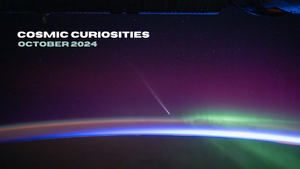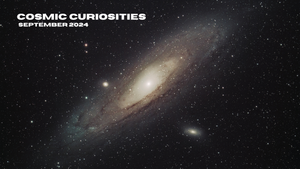
Sep 29, 2024
Scientists may have "cracked the code" with Solar Wind
Since the Soviet spacecraft Luna 1 made its first measurements of solar wind in 1959, scientists have wondered how solar wind continues to receive energy in the form of velocity after leaving the Sun. Well, a group of scientists may have just cracked the code using data from two spacecraft.
Before diving into the rest of the article, I want to cover solar wind quickly. Solar wind is a flow of particles, particularly electrons and photons, originating from the Sun's outermost layer, the corona. Solar wind is constantly present in our solar system, and while it is mostly harmless, it can sometimes interfere with man-made technologies, such as satellites and power grids. Knowing what drives solar wind can allow humanity to better predict surges of solar energy, reducing its impact on our lives, but we'll cover this more later in the article.
Parker Solar Probe finds something shocking
In 2021, NASA's Parker Solar Probe (PSP) made history by being the first artificial object to enter the Sun's magnetic atmosphere. Since then, the probe has been conducting crucial science and has helped astronomers and astrophysicists better understand our host star. One of these discoveries was just how common magnetic switchbacks were throughout solar wind, both near the Sun and further out in the solar system. These switchbacks were first discovered by NASA/ESA's Ulysses spacecraft, but astronomers never really knew how prevalent they were until PSP arrived at the Sun. Think of these switchbacks as a winding road along a mountain. But instead of a road, it is a "lane" of supercharged and smoldering hot electrons and protons in the form of plasma. During PSP's many close flybys of the Sun, scientists noticed that the switchbacks were more distinct and powerful when near the Sun's surface.

Teamwork makes the dream work
While this new data helped piece together some of the mysteries with solar wind, scientists still needed more information before determining how solar wind seemingly sped up well after leaving the corona. That is until about a year later when a cosmic coincidence occurred. NASA's Parker Solar Probe was studying a "strand" of switchbacks up close. Unbeknownst to scientists, the Solar Orbiter, a joint spacecraft mission by ESA and NASA, was studying that same strand of solar wind from a further distance two days after PSP did. What the two spacecraft found was shocking. When Parker observed the solar wind, the probe was riding the edge of the Sun's magnetic atmosphere. It noticed that the solar wind was slow and full of switchbacks. Then, several days later, Solar Orbiter studied a high-speed solar wind beam with very few switchbacks.
We didn't initially realize that Parker and Solar Orbiter were measuring the same thing at all. Parker saw this slower plasma near the Sun that was full of switchback waves, and then Solar Orbiter recorded a fast stream which had received heat and with very little wave activity..........When we connected the two, that was a real eureka moment.” - Samuel Badman, astrophysicist at the Center for Astrophysics and a co-lead of the study
Before this discovery, scientists knew that solar wind moved around the Sun's corona through "Alfvén waves." These waves transport energy through plasma, which makes up the solar wind. However, these waves could never be precisely measured due to the sheer distance between the Sun and Earth. However, due to PSP's record-breaking flybys of the Sun, more data was collected on these waves. The Parker Solar Probe would study how much energy was stored in the wave's velocity and magnetic fluctuations while close to the star. Then, the Solar Orbiter would study waves further away, looking for the amount of energy stored in these fluctuations. Comparing said data from waves up close to waves farther away, scientists have highlighted that the energy used in Alfvén waves, in the form of switchbacks, is enough to account for the heating and velocity of the fast solar wind streams.
While more data is needed to fully develop this new theory, what we've seen so far is quite promising.
What causes the switchbacks?

Well, the short answer at the time of writing this is that we don't exactly know. But within the scientific community, there are a few ideas circulating, with two being clear favorites.
Magnetic Reconnection
Some scientists believe switchbacks are caused by interacting magnetic lines. Imagine these lines as flowing ribbons in the wind or closed systems that loop back to the Sun's surface. This theory was first proposed in 1996, based on data collected from Ulysses. In 2020, scientists Justin Kasper and Len Fisk reexplored this theory with the new data from PSP. When an open and closed part of the magnetic field interacts, they can connect, causing a snap that leads to energy expulsion. This is referred to as interchange reconnection. The sudden snap creates an S-shaped bend in the open magnetic line before closing again.
Magnetic reconnection is a little like scissors and a soldering gun combined into one” - Gary Zank, a solar physicist at the University of Alabama Huntsville
Going with the Flow
On the other hand, some scientists, using computer animations such as Johnathan Squire, are studying how solar wind evolves. They believe that the switchbacks seen originate from turbulent activity from the Sun's rotation. Imagine these waves as a tumultuous river. The rubbing of slow and fast streams of water (in this instance, plasma) creates a swirl effect, similar to eddies in a river. These swirls then grow larger and more powerful, becoming switchbacks.
They start out first as wiggles, but then what we see is as they grow even further, they turn into switchbacks,” - Jonathan Squire, Space physicist at the University of Otago
While the magnetic theory seems to be the more popular answer, scientists will continue to conduct experiments and collect data to find the correct answer. There is also a strong possibility that both processes aid in the formation of switchbacks.
What this means going forward
Studying solar wind is crucial, especially as we enter the solar maxima when the Sun is the most active, which occurs roughly every 11 years. During this maxima, solar activity increases, which can interfere with satellites in orbit. These satellites are crucial to our everyday lives, and if they get knocked out, communication and navigation will be disrupted. Solar storms can also mess with power grids on Earth, further increasing their impact on our lives.
Better forecasting and damage limitation

Solar wind and increased solar activity can be quite consequential for life on Earth. While it doesn't harm humans directly, increased solar activity and large amounts of solar wind pelting our planet have caused some damage to satellites in orbit and even power grids. While I couldn't find an accurate number, damages from solar winds can cost billions of dollars to repair. That only grows as humanity increasingly utilizes GPS, communication systems, and electricity. For instance, in 2022, 40 recently deployed SpaceX Starlink satellites were lost due to a solar storm.
While we can't just stop the solar wind, the best tool we have to limit the damage is forecasting storms before they hit Earth. It takes light from the Sun 8 minutes to reach Earth, which means we only have 8 minutes to take the necessary actions, such as powering down sensitive hardware. This is not much time, but if we can better forecast solar wind, companies with satellites in orbit and power grids on Earth have just a little more time to react and potentially negate all possible damage.
By understanding how solar wind formulates, humanity can better predict when it will be at its worst for Earth, saving tens of billions, if not more, in damages.
Solar wind the future of space travel?

To wrap everything up, I want to quickly cover a fantastic benefit of better understanding solar wind. Knowing what causes or aids solar wind can help us better forecast it, as well as how it interacts with objects in its sphere of influence and, most importantly, Earth. However, knowing more about solar wind may very well help us navigate the solar system.
About a month ago, NASA's Advance Composite Solar Sail System (ASC3) deployed its solar sail while in Earths orbit to further test solar wind as a form of propulsion. Solar sails work because high-speed photons/electrons hit the reflective sail, pushing the spacecraft forward. While this doesn't provide the most thrust, due to the lack of air resistance (drag) in space, using a solar sail to propel a spacecraft may be vital to unlocking more of the solar system. ASC3 wasn't the first time a solar sail was deployed in orbit; in fact, the first solar sail spacecraft was JAXA's IKAROS probe. This probe, launched in 2010, propelled itself all the way to Venus solely by using this technology. By understanding how solar wind works, we can predict how to best use it as a form of propulsion, quite literally propelling humanity into the future.




